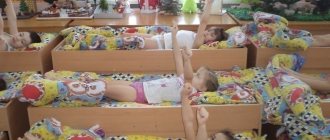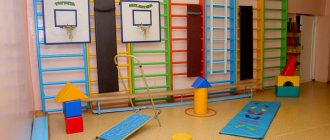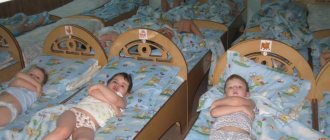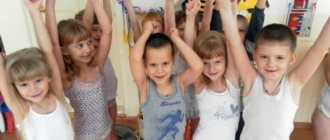COMPLEX OF INVOLVING GYMNASTICS AT MAY Educational and methodological material (senior group)
INVOLVING GYMNASTICS COMPLEX FOR MAY
1st complex "Zhuk"
IP: sitting, legs crossed. Shaking a finger. A beetle flew into our group, buzzed and sang: “Zh-zh-zh!”
Move your hand to the right, follow the direction of your hand with your eyes, and do the same in the other direction.
So he flew to the right, everyone looked to the right.
So he flew to the left, everyone looked to the left.
Move the index finger of your right hand towards your nose. The beetle wants to sit on your nose, we won’t let it sit.
The downward direction of the hand is accompanied by the eyes. Our beetle has landed.
Standing, legs apart. Make rotational movements with your arms (“spinning top”) and stand up.
It buzzed and spun, “Zh-zh-zh-zh-zh-zh-zh-zh-zh-zh.”
Move your hand to the right side, follow with your eyes. The same in the other direction.
Beetle, here is your right palm, sit on it for a while,
Beetle, here is your left palm, sit on it for a little while.
Raise your hands up, look up. The beetle flew up and sat down on the ceiling.
Rise on your toes, look up. We stood up on our toes, but we didn’t get the bug.
Clap. Let's clap together, Clap-clap-clap.
Simulate the flight of a beetle. So that he couldn’t fly away, “W-w-w-w-w-w-w-w-w-w-w-w.”
Beetle, here is your right palm, sit on it for a while,
Beetle, here is your left palm, sit on it for a little while.
Raise your hands up, look up. The beetle flew up and sat down on the ceiling.
Rise on our toes, look up We stood up on our toes, but we didn’t get the bug.
Clap. Let's clap together, clap-clap-clap.
Simulate the flight of a beetle. So that he couldn’t fly away, “W-w-w-w-w-w-w-w-w-w-w-w.”
2nd complex
1. “The eyes are waking up.”
We rub our eyes lightly, and then yawn sweetly.
I. p. - lying on your back, arms along the body. 1-4 - lightly stroke closed eyes; 5-8 - make a relaxing yawning sound. Repeat 4 times.
2. “The head woke up.” We almost woke up and smiled at each other.
I. p. - lying on your back, arms along the body. 1-2 - turn the head on the pillow to the right; 3-4 - and. P.; 5-6 - turn the head on the pillow to the left; 7-8 - and. n. When turning your head, smile at each other. Repeat 6 times
3. “Hands woke up.” We stretched out a little. Hello, sunshine in the window!
I. p. - lying on your back, arms along the body. 1 - raise your right hand up; 2-3 - pull your right hand; 4 - lower your right hand to the bed. The same for the left hand. Repeat 6 times.
4. “Legs woke up.” We also want to stretch and really, really wake up.
I. p. - the same. 1—raise your right leg straight up; 2-3 - stretch your right leg; 4 - lower your right leg onto the bed. The same for the left leg. Repeat 6 times.
5. “My legs are completely awake.” We'll shake our legs and count to three.
I. p. - lying on your stomach with support on your elbows, gently support your chin with your palms. 1-8 - alternately bend and straighten your knees. Repeat 4 times.
We go to wash, we go to dress -
Very friendly guys! Then we'll sing a song.
La la la la la la! This is who we are, friends!
Breathing exercises.
1. "Stork".
IP: As you inhale, raise your arms to the sides. Bring the leg bent at the knee proudly forward and fix it. As you exhale, take a step. Lower your leg and arms, saying “sh-sh-sh.”
2. Balloons."
I.p.: Perform while walking around the site. 1 - arms to the sides, up, inhale through the nose, clap your hands (“the ball burst”); 2 - arms to the sides, down, saying “ssss” or “sh-sh-sh” (“the ball has gone down”).
3. "Crow".
I.p.: o.s. Inhale through your nose, raise your arms up to your sides. Squatting, lower your hands to your head, saying “kar-kar-kar.”
4. “Here is a tall pine tree standing and moving its branches.”
I.p.: o.s. 1—inhale—arms to the sides; 2 - exhale - tilt the body to the right; 3 - inhale - return to the first position; 4 - the same to the left.
5. "Hedgehog".
I.p.: sitting, legs together, arms supported behind. Bend your knees and pull them towards your chest. Straighten your legs (“f-f-f”).
Sleep plays a big role in a baby's life. One of its main tasks is to restore strength from the past day and give energy for the future. The process of waking up after daytime and nighttime sleep is no less important. Most children wake up in a bad mood, and some little ones cannot be woken up at all. This makes life difficult for young parents, since babies can be in no mood throughout the day. To prevent this from happening, you can regularly introduce a healthy set of home exercises into your awakening ritual. You can do gymnastics with your baby without getting out of bed.
Many kindergartens have been practicing children's gymnastics after sleep for several years. It helps babies wake up easier, gives them energy and helps them spend the day more comfortably. Some exercises can be done at home. It is important to exercise in a positive and playful manner so that it is enjoyable for you and your baby.
Little children grow quickly, so it is important to start light physical activity at an early age. In order to grow healthy they will need a lot of strength and energy. Children who are hardened from an early age rarely get sick, and they are also characterized by healthy activity and curiosity. Such kids love to communicate with peers and easily make contact with people.
Gymnastics after a nap develops well:
- vision;
- speech;
- memory;
- endurance;
- patience.
Invigorating gymnastics after sleep helps to cope with waking up easier. Before starting a set of exercises, it is important to prepare your baby’s bedroom:
- ventilate the room;
- let light into the room;
- remove everything unnecessary from the bed and floor so that it does not restrict movement;
- prepare the music;
- if classes are held with additional paraphernalia, it must be prepared in advance. (ball, jump rope, hoop, massage blanket).
You can start doing the exercises right in bed, after the child has opened his eyes. It is important to gradually increase the pace, not to rush:
- Slow awakening . At first, turn on the music quietly, and as you wake up, you can increase the volume. For a more positive mood, choose music that your baby likes, even if it is not too rhythmic. Let the light into the bedroom, open the curtains. Take the blanket off the baby and run your hands over the baby's entire body, starting from the shoulders and ending with the heels. You can give a light massage to your feet and palms.
- Warm up . The simplest thing to start with is stretching. Let your baby stretch several times. Next, you can show your baby an exercise with lifting arms and legs in turn, and also carefully perform circular movements with the neck. Do breathing exercises with your child: inhale and exhale deeply several times. After the child finally wakes up, you can move on to more serious exercises where you need the baby to stand.
- Easy game exercises . Before starting charging, it is recommended to ventilate the bedroom where the baby sleeps. This is done so that you can combine the process of gymnastics with light hardening. Light exercise includes the following set of exercises: get up and walk on your toes, then on your heels, raise your knees high, roll from heel to toe and back, you can make small circular movements with your hands starting from the shoulders, slow bends from side to side, and also back and forth. Then the load can be gradually increased.
As soon as your baby starts doing gymnastics after sleep, the positive effect will not be long in coming. Waking up will not be as difficult for the baby as it was before. In order for the classes to be effective, it is enough to perform the exercises 3-4 times, alternating the load with rest. Then the baby’s muscles will always be in good shape. It is important to ensure that the child’s breathing is uniform and calm during exercises.
The main purpose of the exercises after waking up is that the child, by performing them, moves more easily from a sleepy state to wakefulness.
Exercising after sleep has the following positive effects:
- improves mood;
- increases the child’s perseverance;
- prevents various diseases (scoliosis and flat feet);
- strengthens the respiratory tract system;
- improves the nervous system (makes it more resilient);
- makes the child's immunity strong;
- From childhood, a child begins to lead a healthy lifestyle, starting his day with exercise.
Gymnastics after night and daytime sleep does not make any fundamental difference. The only thing that needs to be adjusted is the time. After waking up at night, you should not study for more than 15 minutes. But after a nap, you can do gymnastics for about half an hour. It is necessary to monitor the child’s condition; the set of exercises should not be tiring. It is important that he finds it interesting and fun. Otherwise, the baby may get bored and subsequently lose interest. To prevent this from happening, monitor your baby’s condition and adjust the time based on his mood. After just a few days of practice, you will know exactly what your child likes.
There are different sets of exercises for each age group. What is suitable for a 2-year-old child will no longer be entirely relevant for a child who is 3 years old or more. Therefore, when choosing exercises, it is important to look at the child’s physical fitness and take into account age restrictions.
Children of school and preschool age can perform more complex physical exercises:
- Cat . The child gets on all fours and bends his back down and back up. The back takes the shape of a wheel.
- Kolobok . The baby lies on his back, tucks his knees to his stomach, wraps his arms around his legs and rolls back and forth, working his abdominal muscles.
- Bike . One of the most popular exercises. It is often done not only by children, but also by adults. The exercise is performed while lying on your back. The child raises his legs and begins to make circular movements, imitating riding a bicycle.
If you do gymnastics, follow all the rules, but the child still wakes up cranky, out of mood, or doesn’t want to get up at all. It is worth paying attention to the rhythm of the baby's day. How long does he stay awake, does the baby sleep enough for his age, is there time in his daily routine for relaxation before bed? Certified children's sleep consultant Tatyana Kremneva will help you understand these and many other questions regarding children's sleep. Come to the “Baby’s Dream” Instagram page, read posts, watch live broadcasts.
Children who exercise after sleep are less likely to get sick or tolerate various diseases much easier. Before you start practicing home gymnastics, you can consult your pediatrician about contraindications.
Author: Tatyana Kremneva.






